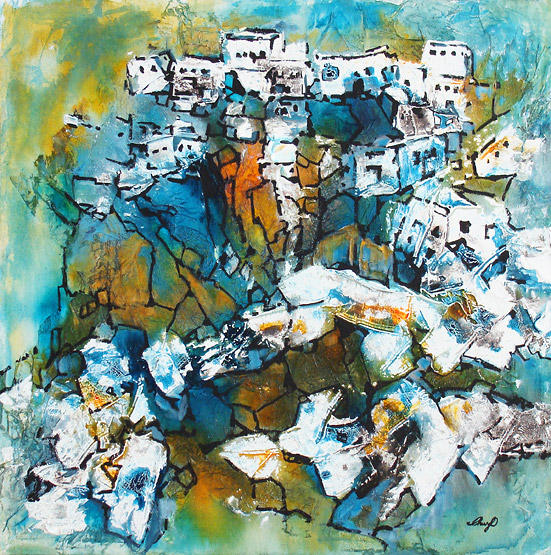 Note: Beginning acrylic painters should choose just one type of acrylic to purchase, either the golden fluid or the heavy body tube acrylics, but not both. (However, intermediate students may decide to mix fluid acrylics and thicker tube acrylics for different effects.)
Note: Beginning acrylic painters should choose just one type of acrylic to purchase, either the golden fluid or the heavy body tube acrylics, but not both. (However, intermediate students may decide to mix fluid acrylics and thicker tube acrylics for different effects.)
The main difference between the 2 types of acrylics is, the fluid acrylic thins easily with water, and the heavy bodied acrylic is made to resist thinning with water. The fluid acrylic is more versatile. It can make effects identical to watercolour, or be used as it comes out of the bottle to make a painting that looks like a smooth surfaced oil painting.
Most beginners will find the fluid acrylic paint easier to work with. The heavy bodied paint is used for paintings where physical texture is wanted – thickly textured paintings.
In either type, please only buy artist quality not student quality paint. Student quality will frustrate you in how they behave in mixtures and slow down the learning curve. Unfortunately, manufacturers often do not put the words “student grade” on the tube or bottle. Example: “Basics” from Liquitex brand is a student grade paint. Do NOT buy those. If unsure, ask the staff at the art store to show you artist quality paint.
Health Note: Some pigments are toxic, but not if used as intended. Specifically; if you find you are frequently getting paint on your hands, it is wise to use a barrier cream before painting. Most cost effective – check the baby department at the drug store, and pick up a tube with the word “silicone” on it. Make sure it is dry on your hands before you touch your paper or canvas.
Golden Fluid Acrylic Paint
This is the type of paint I recommend when a student is having trouble deciding on their choice of paint. It is ideal for smoothly finished, realistic paintings, or can also be used in paint pouring techniques for freer or more abstract effects. When thinned with water or one of the acrylic mediums it can look identical to watercolour.
Here are the recommended starter pigments:
Essential Paints (4 oz. bottles)
|
Optional Paints
|
Mediums (Very Optional) – For those who may want to paint outdoors (plein air).
|
Heavy Body (Thicker) Acrylic Paints
Most beginners will find the Fluid Acrylics listed above easier to handle. For those who prefer to use a heavy-bodied acrylic paint (think thick paint that shows a lot of brush strokes), do start right in at artist quality. You will benefit from experiencing the richer pigment load of artist quality right from the first. The following is a list of Liquitex Artist Quality (NOT Liquitex “Basics” brand) paint. The Golden brand tube acrylics are also an excellent product, you could price compare. The 2 oz tubes will get you started. NOTE: Tube paint comes in different viscosity. Look for the words “Heavy Body” on the tube.
Here is the recommended list:
Essential Paints (2 0z. tubes)
|
Recommended Frequently-Used Paints
|
Mediums (Very Optional)
|
Other Supplies for Both Types of Acrylic
Brushes
The new Synthetic brushes are excellent buys. A medium size round (Size 8 or 10), a 1″, 3/4″ and .5″ square, plus one small triangular painting knife are all that are essential. Optional: a smaller round brush for details. NOTE: Acrylic paint is hard on brushes, never use expensive sable brushes with it, and don’t ever let the paint dry on your brush.
Paper and Canvas
The most cost effective way to buy good quality paper is by the sheet. Ask the staff, the sheets are sometimes tucked away in drawers. I recommend an acid free (not Ph Neutral) 140 lb. with a `Cold Pressed’ surface. Canson and Fluid are both good brands for watercolour paper (but not their all-purpose papers). Buy 2 sheets 140 lb. cold press for starters, or their paper in the blue cover pads is also good. I frequently recommend what size of support (paper or canvas) to bring on the first week in the art course write up. If you are using acrylics in a watercolour manner (i.e. frequently adding water to them), check out even more info about paper in my Watercolour Supplies section. You have choices. Acrylics can also be used on canvas, both pre-stretched canvas and canvas from the roll (get the pre-gessoed type). The canvas sheets can easily be cut with scissors to a smaller size when needed. If you are using watercolour paper or canvas sheets, also buy a light weight corrugated plastic board to tape your paper or canvas sheet onto. Art supply stores sell these. Cut the board to a couple of inches larger than your paper or canvas sheet size. This makes it much easier to paint on and to transport. Pre-stretched canvas is also fine, and much easier to hang because they do not require expensive framing. Note: the cheaper brands of canvas pad can be unpleasant to paint on. Often they are plastic and too slippery a surface.
Miscellaneous Supplies
Any white palette (I use a white porcelain plate), 1 sheet of graphite paper, soft pencil (4B), HB pencil, pencil sharpener, sticky tac or hold-it (better than a kneadable easer), ball point pen, large plastic container for water, shop towels (see note below), small piece of hand soap, 3 ring binder for notes, masking or painter’s tape, 12″ ruler, scissors, and photos for reference (inspiration!).
About Paper Towels
Blue shop towels that come on rolls from a hardware store are much more absorbent than regular paper towels, and can be rinsed out at the end of the painting session and reused multiple times before throwing them away. Much better for the environment, and more pleasant to work with.